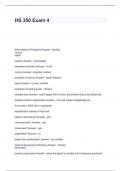Example of coccus - Study guides, Class notes & Summaries
Looking for the best study guides, study notes and summaries about Example of coccus? On this page you'll find 171 study documents about Example of coccus.
All 171 results
Sort by
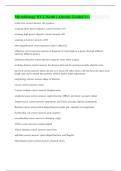 Popular
Popular
-
Microbiology WCC Keith || Already Graded A+.
- Exam (elaborations) • 6 pages • 2024
-
- $10.69
- 1x sold
- + learn more
ocular lens correct answers 10x eyepiece scanning (low) power objective correct answers x10 scanning high power objective correct answers x40 scanning oil correct answers x100 total magnification correct answers ocular x objective refraction correct answers measure of dispersal of visual light as it passes through different material/ different density minimize refraction correct answers using oil, same index as glass working distance correct answers the distance between the ...
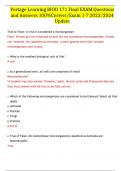
-
BIOD 171 Portage Learning Final EXAM Questions and Answers 100%Correct/Exam 1-7 2023/2024 Update
- Exam (elaborations) • 44 pages • 2023
-
- $20.99
- 5x sold
- + learn more
BIOD 171 Portage Learning Final EXAM Questions and Answers 100%Correct/Exam 1-7 2023/2024 UpdatePortage Learning BIOD 171 Final EXAM Questions and Answers 100%Correct/Exam 1-7 2023/2024 Update True or False: A virus is considered a microorganism. False. Viruses are not living and as such are not considered microorganisms. Viruses can, however, be classified as microbes, a more general term that includes microorganisms and viruses. 1. What is the smallest biological unit of life? A cell. ...
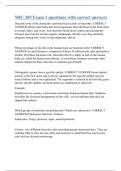
-
MIC 205 Exam 1 questions with correct answers
- Exam (elaborations) • 22 pages • 2023
- Available in package deal
-
- $15.49
- + learn more
Describe some of the destructive and beneficial actions of microbes. CORRECT ANSWER Marine and freshwater microorganisms form the basis of the food chain in oceans, lakes, and rivers. Soil microbes break down wastes and incorporate nitrogen gas from the air into organic compounds, thereby recycling chemical elements among soil, water, living organisms, and air. What percentage of all cells in the human body are bacterial cells? CORRECT ANSWER An adult human is composed of about 30 trillion bo...
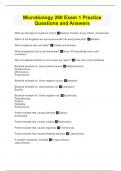
-
Microbiology 260 Exam 1 Practice Questions and Answers
- Exam (elaborations) • 10 pages • 2024
- Available in package deal
-
- $9.99
- + learn more
What are the basic 5 kingdoms of life? Bacteria, Protists, Fungi, Plants, and Animals Which of the kingdoms are synonymous with the word prokaryote? Bacteria Which kingdoms lack cell walls? Protists and Animals Which kingdom(s) lack a cell membrane? None: All living things have a cell membrane Why is it debated whether or not viruses are "alive"? They lack a cell membrane Bacterial example for: Gram positive coccus Staphylococcus, Streptococcus, Micrococcus, Enterococcus Bacterial exampl...
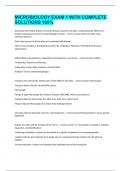
-
MICROBIOLOGY EXAM 1 WITH COMPLETE SOLUTIONS 100%
- Exam (elaborations) • 23 pages • 2023
- Available in package deal
-
- $12.99
- + learn more
MICROBIOLOGY EXAM 1 WITH COMPLETE SOLUTIONS 100% Summarize the relative burden of human disease caused by microbes, emphasizing the differences between developed countries and developing countries. - correct answer Some microbes cause infectious diseases Only a few percent of all microbes are associated with disease Much more prevalent in developing countries (Ex: respiratory infections, HIV, Diarrheal diseases, tuberculosis) Differentiate among bacteria, eukaryotic microorganisms, and v...
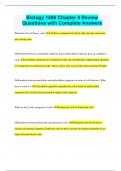
-
Biology 1406 Chapter 4 Review Questions with Complete Answers
- Exam (elaborations) • 8 pages • 2024
- Available in package deal
-
- $9.99
- + learn more
Biology 1406 Chapter 4 Review Questions with Complete Answers What does the cell theory state? All life is composed of cells & cells can only come from pre-existing cells. Differentiate between a unicellular organism and a multicellular organism, give an example of each. Unicellular organisms are composed of only one cell; Bacteria; Multicellular oganisms are composed of a multitude of cells, where a cell is only a part of the entire organism; People. Differentiate between unicellul...
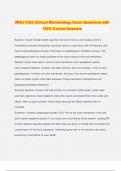
-
WGU C453 Clinical Microbiology Exam Questions with 100% Correct Answers
- Exam (elaborations) • 12 pages • 2024
-
- $12.49
- + learn more
WGU C453 Clinical Microbiology Exam Questions with 100% Correct Answers Bacteria -Answer-Single-celled organism that do not have a cell nucleus and the membrane-enclosed intracellular structures found in most other cells (Prokaryotic cell). Gram-positive Bacteria -Answer-Thick layer of peptidoglycan (20-80nm across). The peptidoglycan layer is closely attached to the outer surface of the cell membrane. Retains crystal violet stains. Lack an outer membrane and a periplasmic space. Gram-neg...
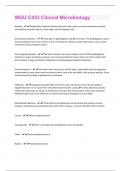
-
WGU C453 Clinical Microbiology | 139 Questions and Answers(A+ Solution guide)
- Exam (elaborations) • 13 pages • 2023
-
- $6.49
- + learn more
Bacteria - Single-celled organism that do not have a cell nucleus and the membrane-enclosed intracellular structures found in most other cells (Prokaryotic cell). Gram-positive Bacteria - Thick layer of peptidoglycan (20-80nm across). The peptidoglycan layer is closely attached to the outer surface of the cell membrane. Retains crystal violet stains. Lack an outer membrane and a periplasmic space. Gram-negative Bacteria - Cell wall is thinner, but more complex. Only 10-20% peptidoglycan. C...
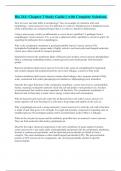
-
Bio 261: Chapter 2 Study Guide || with Complete Solutions.
- Exam (elaborations) • 4 pages • 2024
-
- $10.19
- + learn more
How do cocci and rods differ in morphology? Give an example of a bacteria with each morphology. correct answers Cocci are spherical or ovoid (ex: Streptococcus or Staphylococcus) while rods/bacillus are cylindrical/longer than it is wide (ex: Bacilli or Salmonella). Using a microscope, could you differentiate a coccus from a spirillum? A pathogen from a nonpathogen? correct answers Yes, a coccus is spherical while a spirillum is curved or spiral. No regarding the pathogens from nonpathogens. ...

How much did you already spend on Stuvia? Imagine there are plenty more of you out there paying for study notes, but this time YOU are the seller. Ka-ching! Discover all about earning on Stuvia

